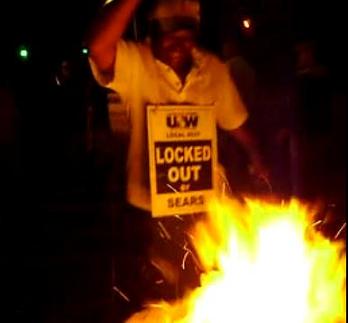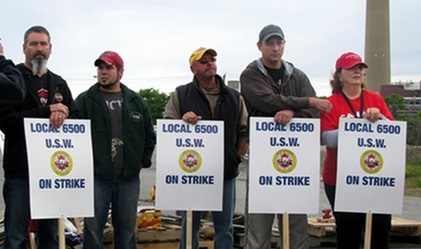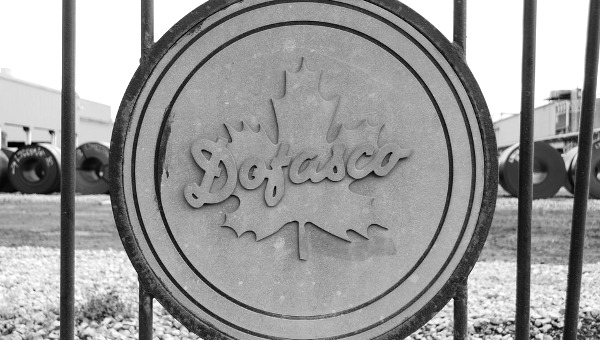The Class Struggle in Vaughan: The Sears Lockout and USW
In the last week of July 2010, workers of United Steelworkers (USW) Local 9537, who have been locked out of their workplace and on the picket-lines for nearly five months, found a big pile of shit sitting right smack-dab by their picket-line outside of a warehouse in Vaughan, just north of Toronto.[1] One could not ask for a better symbol of retail-capital’s attitude toward their workers. Workers at this supply warehouse have been locked-out since April Fool’s Day after rejecting a concessionary offer. They have been fighting an uphill battle against a nefarious employer who has not shrunk from hiring scabs and pitting the warehouse workers against the retail workers. The workers have consistently held the line; they defeated a government-forced ratification vote on May 28, and continue to show anger at their employer. Sears, not unexpectedly has continued to ‘wait it out’ (following the lead of the year long battle between Vale-Inco and USW in Sudbury) predicting that that sooner or later the energy of an isolated union local will dissipate. And the workers will be forced to come back to work with an offer not quite as concessionary, but certainly not a victory.
 What is the symbolic value of shit when Sears has already hired 500 scabs ‘to replace’ the locked-out workers? A Sears representative acknowledged to Toronto Sun columnist Joe Warmington that they had dumped the crap on the line but claimed it was part of regular lawn maintenance. Striking a collegial pose, USW staff representative Terry Bea maintained that the union wasn’t accusing Sears, merely claimed that something odd was going on. But Sears worker Paul Taylor spoke more angrily and bluntly: the picketers believe that the dumping was the work of a “strike breaker from Tennessee.” This episode for Sears workers captures the central issue that is facing the Canadian labour movement: how long will the labour movement continue to take shit from an aggressive union-busting employer before fighting back?
What is the symbolic value of shit when Sears has already hired 500 scabs ‘to replace’ the locked-out workers? A Sears representative acknowledged to Toronto Sun columnist Joe Warmington that they had dumped the crap on the line but claimed it was part of regular lawn maintenance. Striking a collegial pose, USW staff representative Terry Bea maintained that the union wasn’t accusing Sears, merely claimed that something odd was going on. But Sears worker Paul Taylor spoke more angrily and bluntly: the picketers believe that the dumping was the work of a “strike breaker from Tennessee.” This episode for Sears workers captures the central issue that is facing the Canadian labour movement: how long will the labour movement continue to take shit from an aggressive union-busting employer before fighting back?
Sears Workers, USW and Unionism
Sears Canada and Local 9537 had been in bargaining through the early months of 2010. Like in the case of Vale-Inco bargaining with USW, Sears was demanding the type of concessions that even the most conservative business unions wouldn’t accept: rollbacks to pensions, health care and other benefits, vacation days and so forth. According to USW’s external communications, the sticking point making the offer unacceptable was that the contract would stipulate with regards to benefits that they would be “as per the company policy.” Such language would give management control to set and alter benefits on their own as ‘company policy.’ This would, in all likelihood, force the benefits of the unionized warehouse workers down to the level of non-union Sears workers.
Such contractual language would defeat the very purpose of a union. The implication here is that unionized workers would lose out on the improvements to their contracts, not simply monetary gains in wages, since unionizing little over two years (in January 2008) before the round of bargaining. The union rejected the concessionary offer, although it signaled a willingness to continue bargaining. Sears, in contrast, abruptly walked away from the bargaining table on March 23, 2010, and locked-out its workers on the first of April, and continue to avoid bargaining. Why would Sears – or any firm – be so brazen with their union?
Three reasons present themselves: Sears’ desire to remain non-union; the availability of strikebreakers; and their calculation that there would be limited resistance from USW, particularly in light of how USW was stumbling through the major strike at Vale-Inco, and the wider labour movement was all but invisible in its support.
First, Sears Canada has a record of opposing unionization. Sears warehouses are basically unorganized, by USW or any other union. Winning democratic collective bargaining rights can only be seen as a victory, in any component of the distribution network connected to the retail sector. Unionization was proving especially beneficial in reversing the ratio of full time to part-time workers, with part-timers moving into full time work. Those who remained part-time were also entitled to bargaining unit representation. In a moving video interview for Basics News service, a Caribbean-Canadian worker, Michael Smith, speaks with enthusiasm about how much better life is with the union, and using the union’s slogan “we’ll be out one day longer than them.”[2] As Smith points out, this is a precedent that Sears fears. With only 500 of its 30,000 workers unionized, a successful fightback will send a message to the other workers that sticking with the union is a good idea.
Second, it seems clear that Sears assumed that in a lockout they would be able to find scabs to come in to do the work of the locked-out workers. In the midst of a recession and rising unemployment, in an area of Greater Toronto with high migration, a very fluid labour force searching for work and no tradition of unions, Sears clearly determined that if it decided to use strikebreakers, there would be a pool of labour willing to take the work up. In an isolated suburb of Toronto, there was also very little danger that the wider labour movement would organize themselves to block scabs from getting in. The locked-out workers would be on their own, and it was easy enough to work out the logistics of getting them in and out, with nothing in the way of community reprisals to worry about. Indeed, like Vale-Inco, Sears Canada is using AFI International Group, “North America’s leader in crisis management and response,” which is essentially a strike-breaking and scab-firm, to ensure that scabs can get to the workplace. Even in Sudbury, the USW discouraged reprisals against scabs. One can imagine the same messaging is occurring in Vaughan.
Third, when looked at from the perspective of an aggressive employer, it would be easy to make an assessment that in the current period USW has a decidedly mixed record when it comes to successful fightbacks. It is unclear, for instance, how well this new local is being supported and how well the new union members are being educated on union issues and, indeed, even on the lockout. One locked-out worker interviewed by me stated that he was better informed by management than the union. This was even to the point of hearing about the lockout and contract details from management. Yet, this worker was clear that life improved at Sears when the union came in. He said many found the culture of the union very distant, repeatedly mentioning distance between the rank and file and the stewards, even implying that there was more distance between workers and stewards, often off for training sessions, than between workers and management. While understanding of the union and its purposes, this worker feels in the dark about his own union’s demands, tactics and strategy. On the other hand, he feels informed by management, which sends regular “official” information to the workers. Sounding a note of dismay, he said that he felt the lockout could go on for another couple of months, “like Sudbury.”
Observing the fallout of the Vale-Inco strike in Sudbury, the academic and queer activist Gary Kinsman warned of the Steelworkers as too much acting like a “business union.” This was specifically in reference to USW 6500 (and one could also point to the problems that driving instructors of USW 9511 found themselves in, with also an unclear strategy to widen the strike effort and keep members informed). It seems that the description that Scott Neigh applied to USW 6500 might well apply to USW 9537 – “an internal culture that has not always fostered participatory governance or spaces and resources devoted to facilitating social movement-like mobilization of rank-and-file workers.” In Vaughan, as in Sudbury, there is no strategy to politicize the lockout more broadly, draw out community and labour movement support, in the hope that conventional collective bargaining by a few leaders will be enough to defeat an aggressive employer today.
This is not at all to say that the USW’s record is completely bleak. USW Local 1005 at Stelco in Hamilton did a fine job in helping the workers resist concessions and layoffs via developing a more participatory union structure. Through broad community and labour support, they were able to go so far as to ensure that Stelco and U.S. Steel not only got mud in their face, but actually was found to be legally fraudulent. The struggle was waged with broad community support, and was framed not merely as an economic struggle, but a political struggle that united communities across Hamilton. The experiences of the workers of USW 9537, however, are quite different from the Stelco workers.
The Limits of Walking Around in a Circle
So what of the Steelworkers’ tactics in this case? The tactics that the union has been engaging in are basic and primarily limited to the picket-line. This is partly linked to being a new union with minimal demands. One worker wrote on a Facebook discussion forum for Sears workers locked-out that the workers aren’t even asking for anything beyond maintenance of what they already have.[3] There has been little or no discussion of workers gaining more control of their work time, and making any affirmative gains, although Sears remained profitable in the midst of the recession. The union tactics beyond the line have been mainly about telling workers to lobby politicians, Sears management and other stores that do business with Sears (highlighting Sears’ shake-downs of small clothing manufacturers to increase its markup margins). The anger of the workers toward Sears is shown in a video of a spontaneous picket-line action in which Sears contracts are burned over a fire-barrel.[4] The picket strength of the locked-out workers allowed them to defeat resoundingly a forced-ratification vote by the government.

This would seem to indicate that a more political battle with Sears is not impossible. Wider efforts to support the locked-out workers have encouraged a boycott of Sears, and on one level this makes sense. But on another level, it further inconveniences the non-unionized retail workers in addition to the working-class consumers who use stores like Sears to purchase household goods. As one person comments on a Facebook solidarity site that she can’t wait for the lockout to end so she can finally buy a washer and dryer.[5] It is unrealistic to expect people to boycott Sears, or other Sears-affiliated companies like the Eaton Centre, and make the leap from a single isolated local to a city wide boycott in the current political context. The same limit could be said of ‘Facebook activism.’ The use of the Facebook page and social networking in general allow a space for the dissemination of information about Sears’ corporate practices, the lavish lifestyle of Sears financier Edward Lampert, and Sears’ hardball tactics with small suppliers. But people register their solidarity passively.
This is a lockout of a particular vulnerable group of workers trying to convert initial unionization into a deeper presence and gain a foothold across the company. It is tricky to develop the solidarity of workers at one specific warehouse in Vaughan to the different workers under the Sears corporate umbrella. As one worker wrote on a retailworker.com discussion board, “the strike [sic] is affecting the commission associates in our stores who are trying to make a living. Deliveries are being cancelled due to the strike [sic] and you never know when a truck will show up at your store with customer’s merchandise.”[6] Boycotts will not effectively reach out to other Sears workers.
This isn’t to criticize the local union itself, but the limited perspective on how to confront strikes and lockouts by the central union leadership and staff in Canadian unions (not just at USW, but it might be particularly signaled out as it has faced a series of debilitating conflicts now without forging new strategy and tactics). The situation could not be more stark: in a warehouse in Vaughan, in the suburbs of Canada’s largest city and one of its most unionized, with a labour movement formally committed to organizing vulnerable workers in the service sector, Sears is engaged in the mass hiring of scabs and keeping the warehouse running. The tactical limitation of ‘walking in a circle’ hardly needs pointing out, and that actions must be taken beyond picket-lines.
Toward a Political Campaign
What would a political campaign look like, and how would it differ from the tactics that the union is taking on right now? With the length of the lockout and the malaise of the workers of Local 9537, it would seem that one is necessary. There has been a smattering of rank and file activity, such as picketing at other Sears warehouses. But this had only passive support from the union. The fragmented state of the labour movement, and in particular the complete disorganization of the socialist left in the union movement, is certainly a contributing factor to USW’s strategic limits and the lack of tactical innovation.
After all, a truly political campaign would require involvement from a broader base of activists and organizers both within and outside the labour movement. One step might be to replace calls for a boycott with establishing solidarity with Sears retail workers. This could be both in increasing efforts to organize a union among them; but also in finding mechanisms for these workers (perhaps an informal campaign of donating part of commissions to a strike-solidarity fund in return for helping them unionize?) to link up to the lockout and individually become members of USW.
Other means to apply pressure on Sears might also be tried. As opposed to merely disseminating information about Sears’ corporate practices, a political campaign would educate the membership and the public about the broader changes in the retail sector and how Sears is engaged in expanding precarious and degraded working conditions. As well, moving the picket-lines to the downtown core, having mass pickets in front of offices of businesses and holding companies implicated in Sears ownership. Flying squads can be effective, perhaps, in gumming up the works for Sears’ union-busting lawyers and private scab firms. Private investigators can gain all sorts of information as well. Pickets by management households should not be ruled out.
In addition, there is a need for a broad campaign by the labour movement itself that would be much more forceful in preventing scabs from running the warehouse. Some mass confrontations at the warehouse by the labour movement would seem unavoidable, and would immediately raise the profile and political implications of the lockout. It would prove costly almost immediately to Sears just in terms of adverse publicity, but also in the costs of running the warehouse. Tactical imagination has to be encouraged in such settings and in the current political context. The occupation of the Republic Doors and Windows factory in Chicago by its workers, for example, captured the public imagination, as have recent similar tactics by other striking union-locals and students. Could Sears workers attempt to occupy their workplace to prevent scab labour from ‘replacing’ them? What might other tactics look like? The social and political costs for Sears, and other firms in the retail sector, need to be raised when they pursue anti-union, indeed union-busting, methods.
The issue of a lack of broad support for rank and file political campaigns is not at all limited to USW. It seems to be the name of the game in the labour movement in Canada right now. As of late, strikes (and lockouts) in Ontario have been both long, drawn out, and often isolated. Take the recent Cadillac Fairview lockout and quasi-victory. Sam Gindin rightfully refers to the lack of concrete movement participation, outside of the small but dedicated Toronto labour-left, as exposing the labour movement as a “paper tiger.” This seems especially the case in the private sector right now, where employers are being particularly aggressive in demanding concessions, workers facing more vulnerable and precarious work conditions, and unions are more isolated in their day-to-day struggles with the company. Public sector workers are now facing their own challenges from the austerity drive by governments. However, there are often more concrete, built-in links between workers, social movements and the intelligentsia, such as at universities or museums and the like, within the public sector.
It would be hard not to conclude that business unionism is on the rise in Canada and the United States as a defensive response to the economic crisis and the disorganization of the left. To adopt a phrase from Ellen Wood, there is a “formal separation” between social movements and the labour movement. An anti-capitalist political campaign in a union conflict would ensure these workers are not being isolated at a practical level in the immediate conflict, but also at a theoretical as well in trying to educate and make linkages between workers. While initiatives like the Greater Toronto Workers’ Assembly are attempting to negate this formal separation and go beyond the politics of ‘networks,’ the on-the-ground struggles of labour and social movements are crucial.
The broader labour and progressive social movements must work in solidarity with the locked-out workers of USW Local 9537, and help them build by advancing a political campaign as described, to move beyond walking in a circle. This means not just joining Facebook groups, or even visiting the picket lines for a few hours, but rather in providing a compass with which to navigate a more militant fightback, to encourage the workers not to simply accept a ‘slightly better’ deal than they rejected, but to fightback to win. If Sears wants to hire scabs and leave sacks of shit on the picket-line, then the union must be prepared to fight as deviously as the employer. Of course, it’s up to all of us to help them out, without illusions, but with political spine, and with a focus on building new capacities through participation, and organization building. •
Footnotes
1.
Joe Warmington, “Labour Situation at Sears just stinks!,” Toronto Sun, August 5, 2010.
2.
Report from the Picket-line, Basics News, YouTube, April 29, 2010.
3.
Facebook –Solidariy with Locked Out Sears Workers.
4.
“USW Local 9537 – Contract Response” – May 28, 2010 – note the contracts burned in this video-clip are the ones defeated in the forced rat vote.
5.
Facebook – Solidarty with Locked Out Sears Workers.
6.
Retailworkers.Com – Discussion of Sears labour practices.




